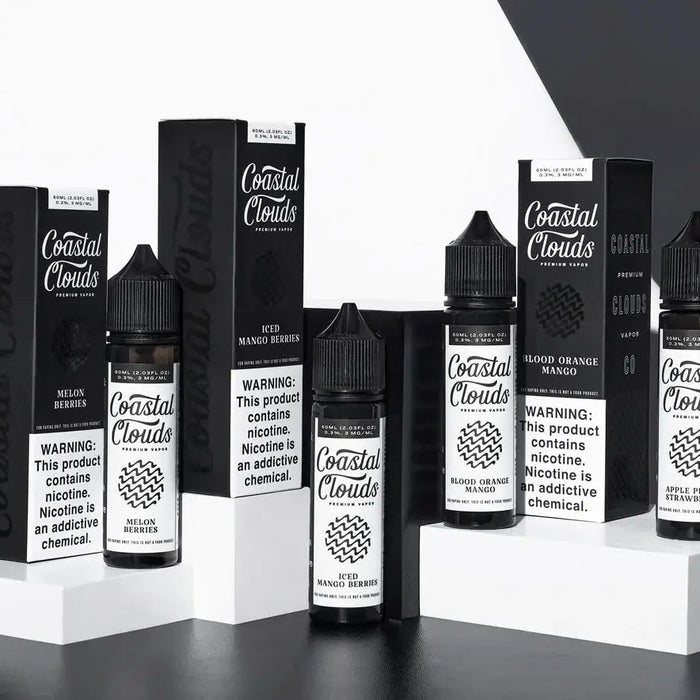Ahhh temperature control. The strange feature on your mod that you wished you knew how to use but figured you’d stick to the normal way of wattage vaping. It even tells you on the coils what wattage is the best to vape at, so why try anything different? Simple: temperature control vaping minimizes the chance of dry hits or burnt hits, as well as keeping the coil at a steady temperature instead of gradually getting hotter due to the wattage use. Temperature vaping also lets the user limit the range, usually between 300°F - 600°F, and offers greater control of your vape and coil within a specified temperature. Sounds cool right? Let’s dive right in and learn about what TC vaping is, how it originated, and how you can change your vaping habits today!
WHERE DID TEMPERATURE VAPING COME FROM?
In 2014, a company named Evolv decided there had to be a better way of vaping. They created something called a DNA chip that allowed the user to control how hot the coil would get, instead of relying on the wattage method to get their e-liquid vaporized. Mods with these DNA chips are still widely considered to be the best on the market and many companies won’t even sell mods without the TC option. Even the familiar method of wattage vaping was created by Evolv, so you can only imagine what this innovative company will come up with next!
TEMPERATURE CONTROL: HOW DOES IT WORK?
The idea behind TC vaping is relatively simple. Set the temperature, take a puff, and that’s it! But for those who would like a technical answer, it starts with heat and metal, or more specifically, your mod’s power and your coil’s metal makeup. As coils heat up, the metal of the coil increases its resistance. The “Ω” sign lets you know the resistance of that metal and it’s called your ohm’s level. Certain metals work differently than others. For example, Kanthal metal is hands-down the most popular vape wire because its resistance value remains the same regardless of the temperature. You’ll need to make sure the wires that you do use are well-know to be resistant to increasing in temperature as the temperature rises. Your mod will check the coil’s resistance once at room temperature, then continuously monitor the temperature as you use your vape. Any change in the resistance gets converted into an increased temperature and the mod will adjust the power to keep your wire at the specified temperature. It’s very similar to cruise control in cars. No matter if you go uphill or downhill, your car will automatically adjust the power to keep the car at the specified speed.
WHAT DO I NEED TO VAPE IN TEMPERATURE CONTROL?
As we mentioned before, most vapes come with TC modes already built in, but that doesn’t mean they’re all equal. While Evolv and Yihi are regarded as the best mods to use for TC, they can run quite a bit on the expensive side and may be difficult to find. However, you may have heard of other companies such as Vaporesso, Aspire, Smoant, and Modefined. These companies have done a stellar job of creating temperature control mods that are both reliable and affordable.
In addition to having the appropriate mod, you’ll also need to use the correct type of wire. You’ll see a list of supported wire types on many mods that may have confused you in the past, but we’ll go over why they’re important now. Nickel 200 (or Ni200) was the first TC coil, but due to user sensitivity with nickel coils, it died out in popularity. Titanium Grade 1 (or Ti) is another option, but the user must be cautious to ensure this wire doesn’t get overheated. Stainless steel is by far the most popular now because of its availability and ability to be used with both wattage use and TC modes. The most common grade of stainless steel is SS316L, but is also available in 304, 316, 316L, 317, and 430. Finally, we have Nickel Ferrous (or NiFe). This is more rare to use, as it’s not readily available, but in the chance you do find it and wish to use it, it comes in grades of 48, 30, 52, and 70. Like Stainless Steel, it can be used in both wattage and TC mode.
All of these wires have a TCR, also known as a temperature coefficient of resistance. Wikipedia describes this as “the relative change of a physical property that is associated with a given change in temperature.” Simply put, in order to send the right level of power to your coil, your mod reads that TCR to know the limits of your specific wire. TC coils can have a low resistance so it’s not something you should just wildly guess. Thankfully, most of the TC mods available already have presets for Ni200, Ti and SS (316L) to ensure that you’re getting the right amount of power for each TC wire. If you prefer to set your own, try to find a mod that lets you customize your TCR. You can then input the values into your mod based on your metal grade and type.
HOW CAN I VAPE IN TEMPERATURE CONTROL?
Now that we’ve gotten the specifics of TC vaping, it’s time to put that knowledge to the test. You’ll have to choose your wire type in the mod settings, either using the presets or the exact values of your TCR. It’s very important that both the mod and tank are at room temperature, so don’t leave your vape outside in your car where the heat or cold can affect the readings. If you’re wanting to switch the modes while you’re using the mod, let the tank and mod rest for about 15 minutes before switching over to TC mode. Next, make sure your coil is screwed in tightly (if you’re using rebuildables, ensure that the leads are firmly tapped). Finally, screw your tank/atomizer onto your mod. You’ll want to make sure it’s firmly secured, but not overtightened. Double check your resistance to ensure an accurate reading and press the +/- buttons to confirm the resistance is locked in.
For those of you using rebuildables, make sure that you’re using stainless steel, as that’s the only material that can be used for dry burning in temperature control mode. You should also use lower wattages than you would for other materials like Ni80 or Kanthal. You don’t have to dry burn your coils; if you’ve spaced your coils slightly, you shouldn’t have any hot spots. The resistance will also be simpler and more consistent for your mod to detect and identify. Keep in mind that some mods will automatically set your wattage for you, whereas others are user friendly and you can set your own wattages and temperatures. You should set your temperature and wattage to the lowest level that’s marked on the coil if you’re using stock coils and wanting to adjust the coils. You can gradually increase your wattage level and temperature to find out what works best for you.
WHAT IS THE BEST TEMPERATURE TO VAPE IN TC MODE?
Obviously with all your newfound knowledge of vaping in TC mode, you’re going to want to know what’s the best temperature to vape at. Many vapers stay within the range of 392°F to 480°F (or 200°C to 250°C ). You can adjust the temperature in increments of 10°F (5°C) until you find you preferred temperature. Since you’re in TC mode, you shouldn’t have to worry about the coil or wick overheating, unless you’re running low on juice. When that happens, you’ll notice the amount of vapor produced from each inhale be significantly less. You can either refill the juice or lower your temperature until you can refill, but not too low. Since TC coils have a very low resistance, you’ll need to stay at a reasonable temperature for them to be heated properly.
PROS AND CONS OF TEMPERATURE CONTROL
There are many pros and cons of TC vaping, which we’ll run through briefly before sending you on your way. If you’re looking to prevent dry hits or burnt taste in your coils, TC mode does it for you (just like cruise control) by adjusting your temperature when you run low on juice. The low amount of vapor produced will remind you to put juice instead of a nasty dry hit. A second pro is that you’ll be able to get greater use out of your coils, since the TC helps prevent the coil from overheating and burning the cotton. The wicks will also last longer since they’re not forced to go above the recommended temperature needed for a satisfying vape experience. Next, using TC helps to extend the life of your batteries. It’s estimated that using temperature control uses nearly 1.5 times less power that vaping in wattage mode. By using less power, you should see your batteries last significantly longer. Lastly, you’ll notice that you’ll have a more consistent vape experience based on temperature. With wattage mode, your temperature will vary as the heat of the coil will be different in each puff, due to the coil heating up to the set wattage instead of just the set temperature.
The cons are pretty straightforward but are worth mentioning. It might seem like everyone should be vaping on TC since the pros are almost a no-brainer. But keep in mind that most mods are preset to be on wattage mode. Since vaping already comes with a steep learning curve, it’s best to start out with wattage mode until you’re comfortable with vaping and are ready for a more advanced vaping experience. Most coils already have the suggested wattage engraved right on the coil but you’ll have to play around with the TC until you find a temperature that’s right for you. Keep in mind that not all mods come with a TC mode, especially the cheaper mass-produced ones. If you think that you’ll make good use out of the TC mode, make sure you do your research before buying a mod. Lastly, TC mode requires a specific coil metal type, like Kanthal and Ni80. Most coils don’t come with an option to vape in TC, so you’re forced to build your own coil to really make the most of your TC vape experience.
CONCLUSION
We’ve tried to exhaustively cover everything you need to know about temperature control vaping. It’s an excellent choice for more intermediate vapers who want to limit dry hits and burnt tastes, but it comes at the cost of building your own coils with the appropriate materials and having a mod that supports this feature. Like any good thing, vaping in TC will require patience and a mild amount of work, but the end result is extremely worth it. Do you have any questions about TC vaping? Perhaps you’ve tried it and have some words of wisdom to pass onto fellow vapers reading this article. Post your comments below and share your knowledge! Join us next time where we review the Mag P3 mod from Smok! As always, may your tank always be full of delicious e-liquid and your clouds forever full of flavor!




